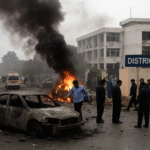Every winter, Delhi turns into a gas chamber. Eyes burn, throats hurt, and stepping outside feels like walking into a smoke cloud. So when we all heard about artificial rain being used to clean the air this time, there was hope.
But the truth?
It didn’t work. And people were left confused.
Let’s break down why artificial rain failed in Delhi, in simple words.
☁️ First – What Was the Plan?
The idea was pretty straightforward:
Cloud seeding → Make it rain → Rain washes out pollution → Air becomes clean
Sounds perfect, right?
Unfortunately, nature had other plans.
❌ Real Reasons Artificial Rain Failed in Delhi
1. There Were No Rain-Ready Clouds
Artificial rain only works when clouds already have good moisture.
But during the trial, winter clouds over Delhi were too dry.
Humidity was barely around 15–20%, while cloud seeding needs 60% or more.
No moisture = No rain.
It’s like trying to squeeze water from a dry sponge. Impossible.
2. Winter Weather Traps Dirty Air
Delhi’s winter has a sneaky enemy – temperature inversion.
Cold air stays near the ground
Warm air stays above
Pollution gets trapped like a lid on a pot
Winds are weak too, so smoke just hangs.
Even if small drizzle happened, pollution would still stay stuck low.
3. Pollution Sources Never Stopped
Let’s be honest — the smoke keeps coming every second:
•Cars and bike traffic
•Factories and industrial units
•Construction dust
•Crop burning from nearby regions
•Generator fumes
•Road dust and garbage burning
How can rain clean air if pollution keeps pouring in?
It’s like trying to mop the floor while a tap is still leaking nonstop.
4. Cloud-Seeding Isn’t a Magic Button
Cloud-seeding can improve rain chances…
But it cannot force rain from empty clouds.
Some countries use it successfully — but only when weather supports it.
5. Big Cost, Tiny Result
The trial cost crores.
End result? Barely any rain. No major AQI improvement.
People expected relief.
All they got was disappointment — and continued smog.
🟦 What Can Actually Clean Delhi’s Air?
Real pollution control takes long-term steps, like:
•Better waste and dust management
•Cleaner fuel and emission enforcement
•More electric public transport
•Support for farmers to manage crop waste
•More green belts and urban forests
•Strict industrial monitoring
•Tech-based air filtration zones in critical hotspots
Rain — natural or artificial — can help temporarily, but it’s not a permanent fix.
Think of it as a painkiller, not the cure.
🤔 Quick FAQs
✅ Did artificial rain help Delhi?
Not really. Rain didn’t happen, so pollution stayed high.
✅ Can artificial rain reduce pollution?
Only when weather conditions are supportive.
✅ Was this experiment useless?
Not useless — but mistimed. Winter is the toughest season for cloud seeding.
✅ What improves air fastest?
Natural rain + strict pollution control + cleaner transport.
📌 Bottom Line
Artificial rain sounded like a miracle idea.
But nature doesn’t follow human deadlines or press conferences.
To breathe clean air, we need consistent effort — not one-day experiments.
Strong planning, clean energy, and year-round pollution control can bring real change.
And honestly, Delhi deserves that.
This article will be updated regularly with new insights and data.










